The Constellation of Orion: A Perspective
advertisement
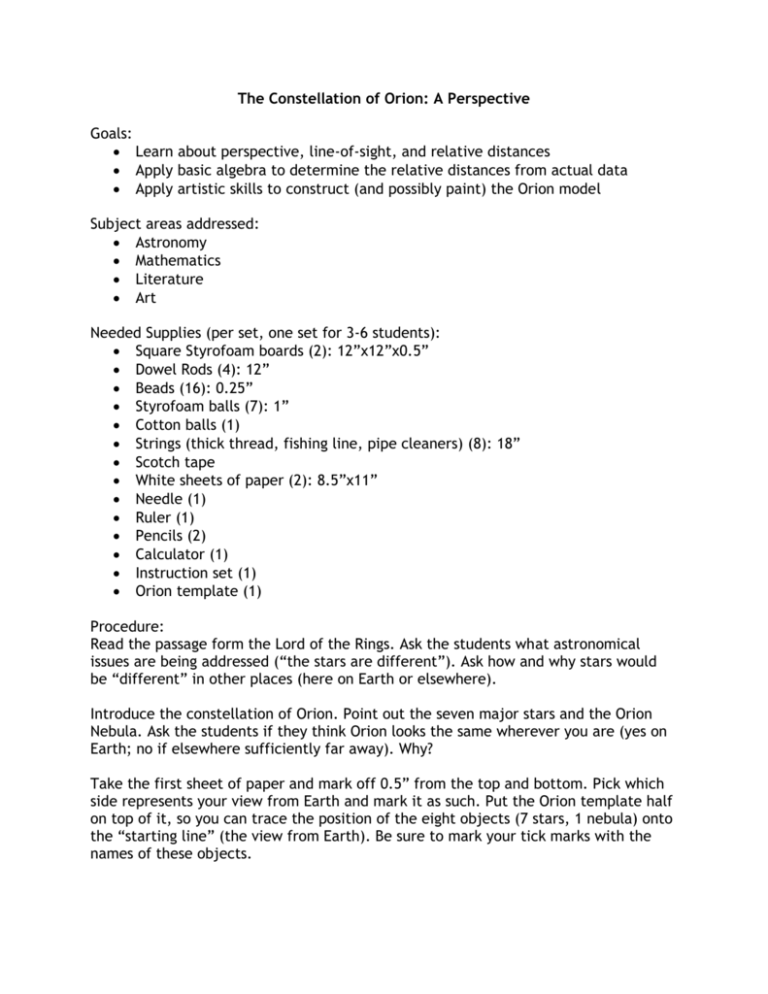
The Constellation of Orion: A Perspective Goals: Learn about perspective, line-of-sight, and relative distances Apply basic algebra to determine the relative distances from actual data Apply artistic skills to construct (and possibly paint) the Orion model Subject areas addressed: Astronomy Mathematics Literature Art Needed Supplies (per set, one set for 3-6 students): Square Styrofoam boards (2): 12”x12”x0.5” Dowel Rods (4): 12” Beads (16): 0.25” Styrofoam balls (7): 1” Cotton balls (1) Strings (thick thread, fishing line, pipe cleaners) (8): 18” Scotch tape White sheets of paper (2): 8.5”x11” Needle (1) Ruler (1) Pencils (2) Calculator (1) Instruction set (1) Orion template (1) Procedure: Read the passage form the Lord of the Rings. Ask the students what astronomical issues are being addressed (“the stars are different”). Ask how and why stars would be “different” in other places (here on Earth or elsewhere). Introduce the constellation of Orion. Point out the seven major stars and the Orion Nebula. Ask the students if they think Orion looks the same wherever you are (yes on Earth; no if elsewhere sufficiently far away). Why? Take the first sheet of paper and mark off 0.5” from the top and bottom. Pick which side represents your view from Earth and mark it as such. Put the Orion template half on top of it, so you can trace the position of the eight objects (7 stars, 1 nebula) onto the “starting line” (the view from Earth). Be sure to mark your tick marks with the names of these objects. From the table of stars pick the one furthest away ( Ori, 1342 ly), and mark that on the far side from Earth (at 10” distance) exactly opposite the corresponding tick mark on the Earth side. Now we are ready to do some math. We need to figure out the relative distances of the other seven objects. Math: if 1342 ly corresponds to 10 inches, 1 ly corresponds to 10/1342 inches. Therefore, 427 ly ( Ori) corresponds to 3.18 inches. Do this for all the objects, and mark their positions on the paper exactly opposite their tick marks on the Earth side. Then put this paper onto one of the Styrofoam squares, put the other paper underneath, and the second Styrofoam square under that. Now take the needle, and punch one hole at each of the eight object positions through both papers and squares. Be sure to mark the orientation of the squares. Someone else can meanwhile knot one bead at the end of each string. Once we have made the holes, use the needle to put one thread through each hole of the bottom paper/Styrofoam combo. Then, put one Styrofoam ball onto each string for the stars, and the cotton ball for the nebula. Have one person hold up the Orion template on the far side from Earth, so that we can determine how high up the objects should be. Determine the height (eyeball it), then put a bit of scotch tape under each object to keep it in place. Next put the dowel rods in each corner. Be very careful of the orientation of the top paper/Styrofoam combo (the paper should be on top). Then use the needle to put the top of each thread through the appropriate hole in the top plate. Finish by tying a bead to each thread to keep things in place. We now have a distance scale model of the Orion constellation. When looking at this model from the Earth side, we see the familiar constellation. But when looking at it from the side, it looks very different. The stars that appear next to each other in constellations are in reality nowhere near each other. So when viewed from anyplace but Earth, folks would see something very different. It might be an interesting exercise to have the students design a new constellation from the Orion stars based on the different view point. Possible additions/improvements: The stars and nebula are nowhere near to scale, that is an improvement left to the students. This construct tends to be wobbly, enterprising engineering students could probably come up with sturdier ideas. Art enthusiasts could paint the stars and nebula appropriate colors. Design a new constellation with the same objects from the new view point Other examples from literature can be found to illustrate the point of this exercise. Add kits for other constellations for variety with large groups Cindy Fong’s Suggestions: I've used PVC pipes for to help my students visualize earth structures... I realize I can do the same with this and am in the process of making kits. As teachers, we have to think what will work quickly and effectively... can we make a kit that can be used in a variety of applications and yet be affordable. What you presented above works nicely for a smaller class but when you deal with 120 + students per teacher - the above becomes too costly and unless it is planned in advance - it comes out of the teacher's pocket. I'm in the process of getting 1/2 PVC pipe and corners and instead of my 6'x'6'x6' cube, I'm reducing it to a number of 18" cubes, placing a plastic grid on top (or the students can run string across) as the anchor points. They then can do a shadow box of the Orion's constellation. Bigger upfront cost but in the long-run, for me, easier to deal with since I have been having only one class do the huge cube and leaving it out for students in all classes to check and study from. I've been doing this for 4 years with the ocean floor structures - time to upgrade. ;-) What would be cool is to have a variety of different constellations for the students to make and then we can break a class into groups with each group doing different constellations. It then becomes an activity that is easily shared and discussed. So, having multiple tables that the teacher can hand to groups would be cool. Adam suggests "tinkertoys" - readily available, can use sticks that go at right angles.

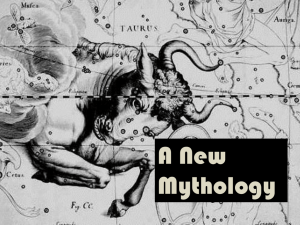
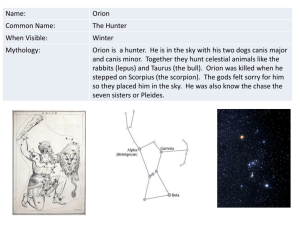
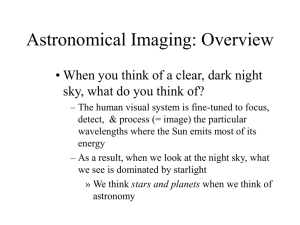

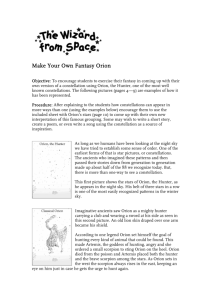
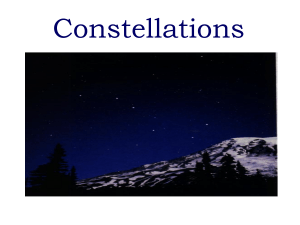
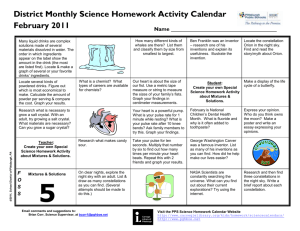
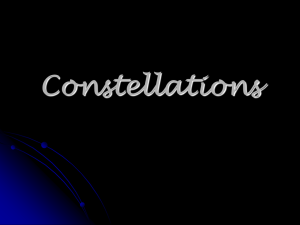
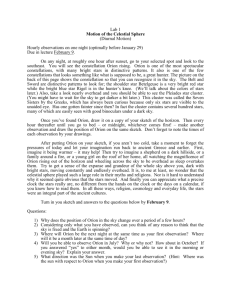
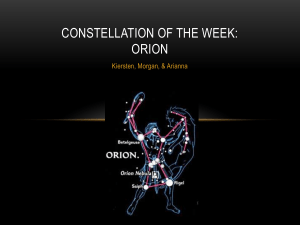
![Orion's_Nebula[1]](http://s2.studylib.net/store/data/010164075_1-f72c41f52afb208225de67e18e05f3bb-300x300.png)